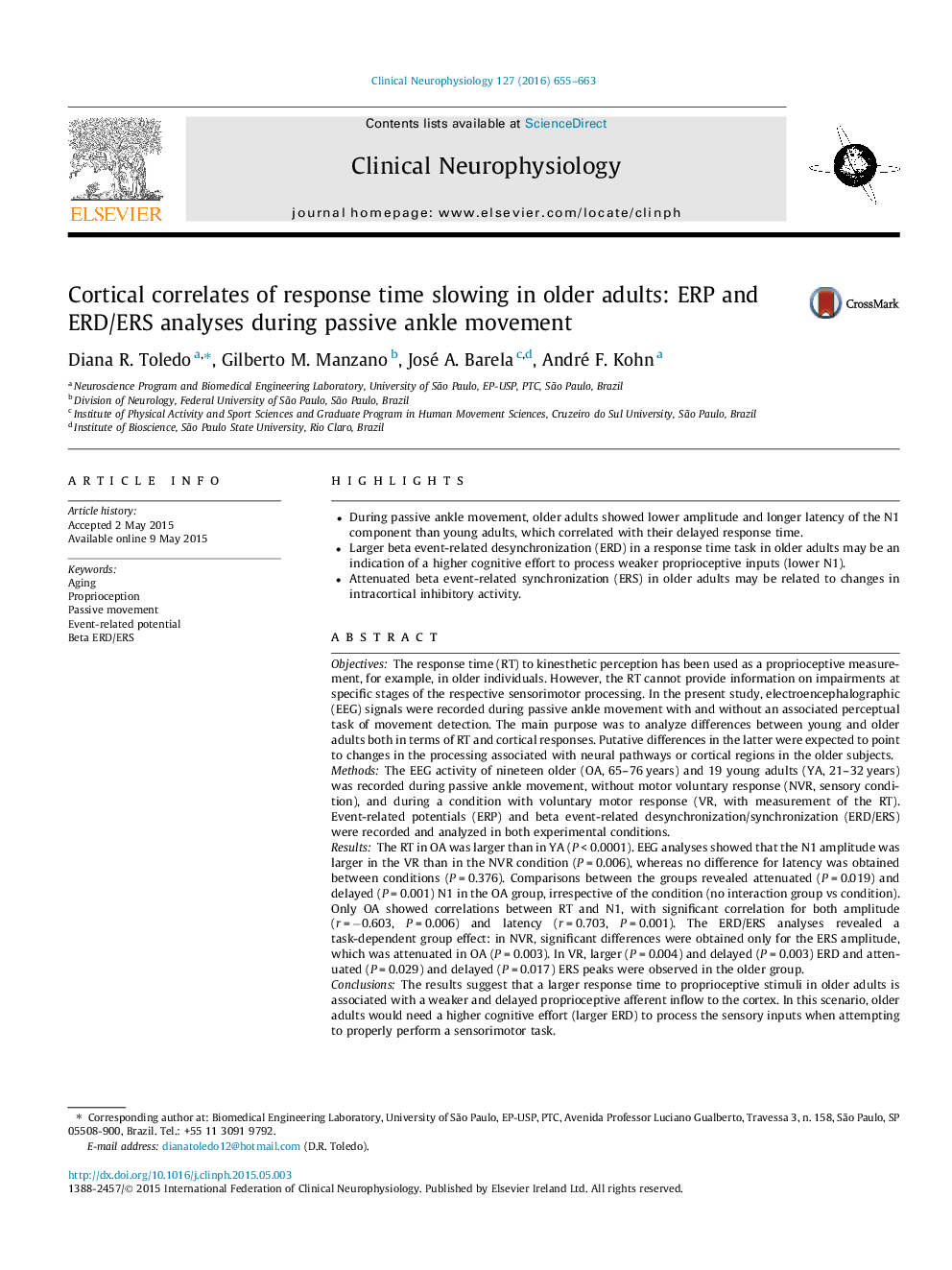| کد مقاله | کد نشریه | سال انتشار | مقاله انگلیسی | نسخه تمام متن |
|---|---|---|---|---|
| 6007958 | 1184960 | 2016 | 9 صفحه PDF | دانلود رایگان |

- During passive ankle movement, older adults showed lower amplitude and longer latency of the N1 component than young adults, which correlated with their delayed response time.
- Larger beta event-related desynchronization (ERD) in a response time task in older adults may be an indication of a higher cognitive effort to process weaker proprioceptive inputs (lower N1).
- Attenuated beta event-related synchronization (ERS) in older adults may be related to changes in intracortical inhibitory activity.
ObjectivesThe response time (RT) to kinesthetic perception has been used as a proprioceptive measurement, for example, in older individuals. However, the RT cannot provide information on impairments at specific stages of the respective sensorimotor processing. In the present study, electroencephalographic (EEG) signals were recorded during passive ankle movement with and without an associated perceptual task of movement detection. The main purpose was to analyze differences between young and older adults both in terms of RT and cortical responses. Putative differences in the latter were expected to point to changes in the processing associated with neural pathways or cortical regions in the older subjects.MethodsThe EEG activity of nineteen older (OA, 65-76 years) and 19 young adults (YA, 21-32 years) was recorded during passive ankle movement, without motor voluntary response (NVR, sensory condition), and during a condition with voluntary motor response (VR, with measurement of the RT). Event-related potentials (ERP) and beta event-related desynchronization/synchronization (ERD/ERS) were recorded and analyzed in both experimental conditions.ResultsThe RT in OA was larger than in YA (P < 0.0001). EEG analyses showed that the N1 amplitude was larger in the VR than in the NVR condition (P = 0.006), whereas no difference for latency was obtained between conditions (P = 0.376). Comparisons between the groups revealed attenuated (P = 0.019) and delayed (P = 0.001) N1 in the OA group, irrespective of the condition (no interaction group vs condition). Only OA showed correlations between RT and N1, with significant correlation for both amplitude (r = â0.603, P = 0.006) and latency (r = 0.703, P = 0.001). The ERD/ERS analyses revealed a task-dependent group effect: in NVR, significant differences were obtained only for the ERS amplitude, which was attenuated in OA (P = 0.003). In VR, larger (P = 0.004) and delayed (P = 0.003) ERD and attenuated (P = 0.029) and delayed (P = 0.017) ERS peaks were observed in the older group.ConclusionsThe results suggest that a larger response time to proprioceptive stimuli in older adults is associated with a weaker and delayed proprioceptive afferent inflow to the cortex. In this scenario, older adults would need a higher cognitive effort (larger ERD) to process the sensory inputs when attempting to properly perform a sensorimotor task.SignificanceERP and ERD/ERS measurements during kinesthetic assessment provide new insights on identification of the origin of sensorimotor slowing in older adults.
Journal: Clinical Neurophysiology - Volume 127, Issue 1, January 2016, Pages 655-663